Critically Evaluating Wenzel's International Entrepreneurship Strategy
VerifiedAdded on 2021/02/21
|9
|2144
|360
Report
AI Summary
This report provides a comprehensive analysis of Wenzel's international entrepreneurship strategy, specifically focusing on their approach to entering new markets. The report delves into the concept of international entrepreneurship, emphasizing the significance of firm internationalization, network establishment, and adaptation to cultural diversity. It examines Wenzel's chosen market entry strategy, which is direct exporting, and evaluates its advantages, such as higher profits, control over operations, and consumer understanding. The report also acknowledges the disadvantages of direct exporting, like the need for strong consumer relationships and increased responsibility. The analysis includes a critical evaluation of the chosen strategy, considering factors like market feasibility, competitor strategies, and consumer preferences, and concludes with insights on the importance of planning and coordination in international business, along with the implications for entrepreneurial success. The report uses various academic sources to support its arguments and provides a solid foundation for understanding international market entry strategies.

INTERNATIONAL
ENTREPRENEURSHIP
ENTREPRENEURSHIP
Paraphrase This Document
Need a fresh take? Get an instant paraphrase of this document with our AI Paraphraser
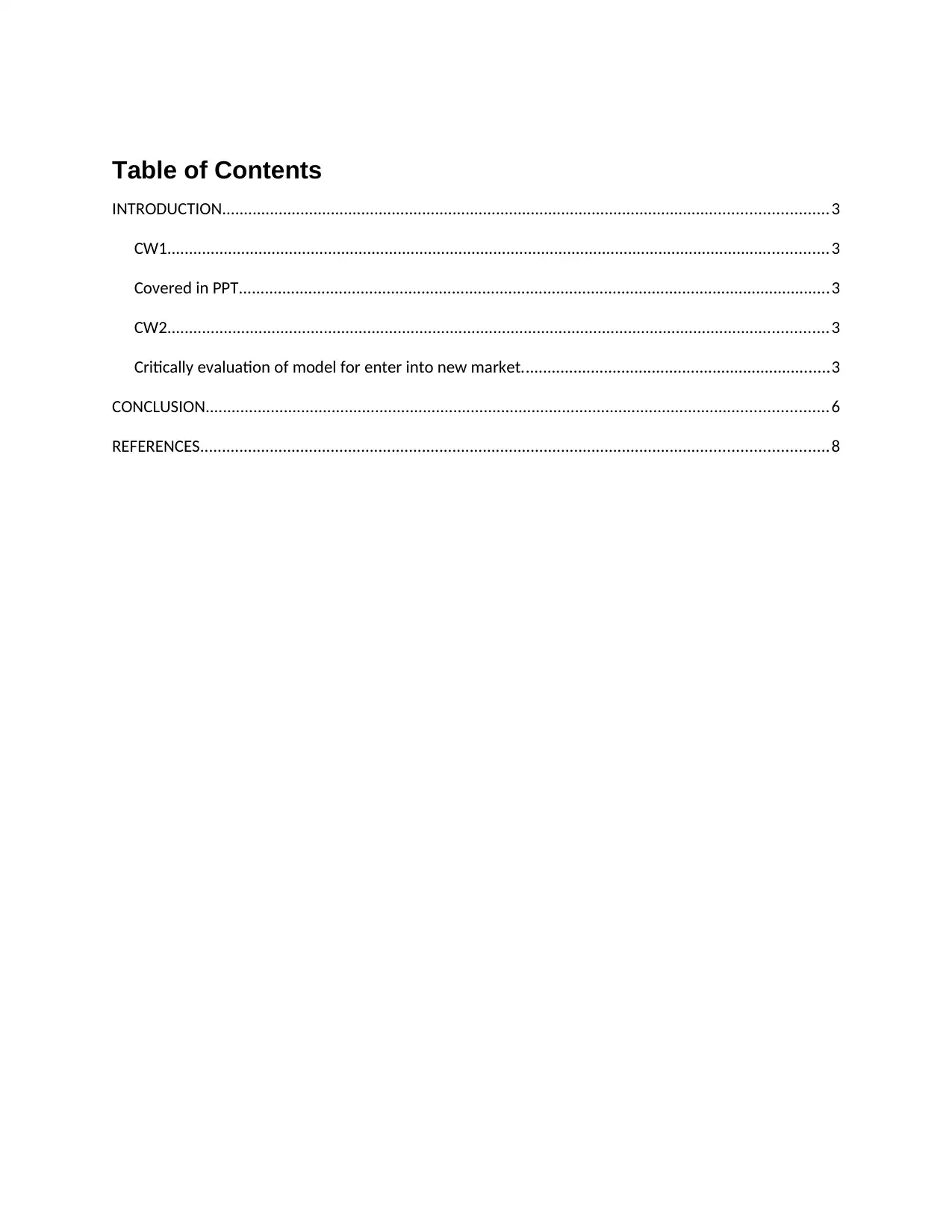
Table of Contents
INTRODUCTION...........................................................................................................................................3
CW1........................................................................................................................................................3
Covered in PPT........................................................................................................................................3
CW2........................................................................................................................................................3
Critically evaluation of model for enter into new market.......................................................................3
CONCLUSION...............................................................................................................................................6
REFERENCES................................................................................................................................................8
INTRODUCTION...........................................................................................................................................3
CW1........................................................................................................................................................3
Covered in PPT........................................................................................................................................3
CW2........................................................................................................................................................3
Critically evaluation of model for enter into new market.......................................................................3
CONCLUSION...............................................................................................................................................6
REFERENCES................................................................................................................................................8
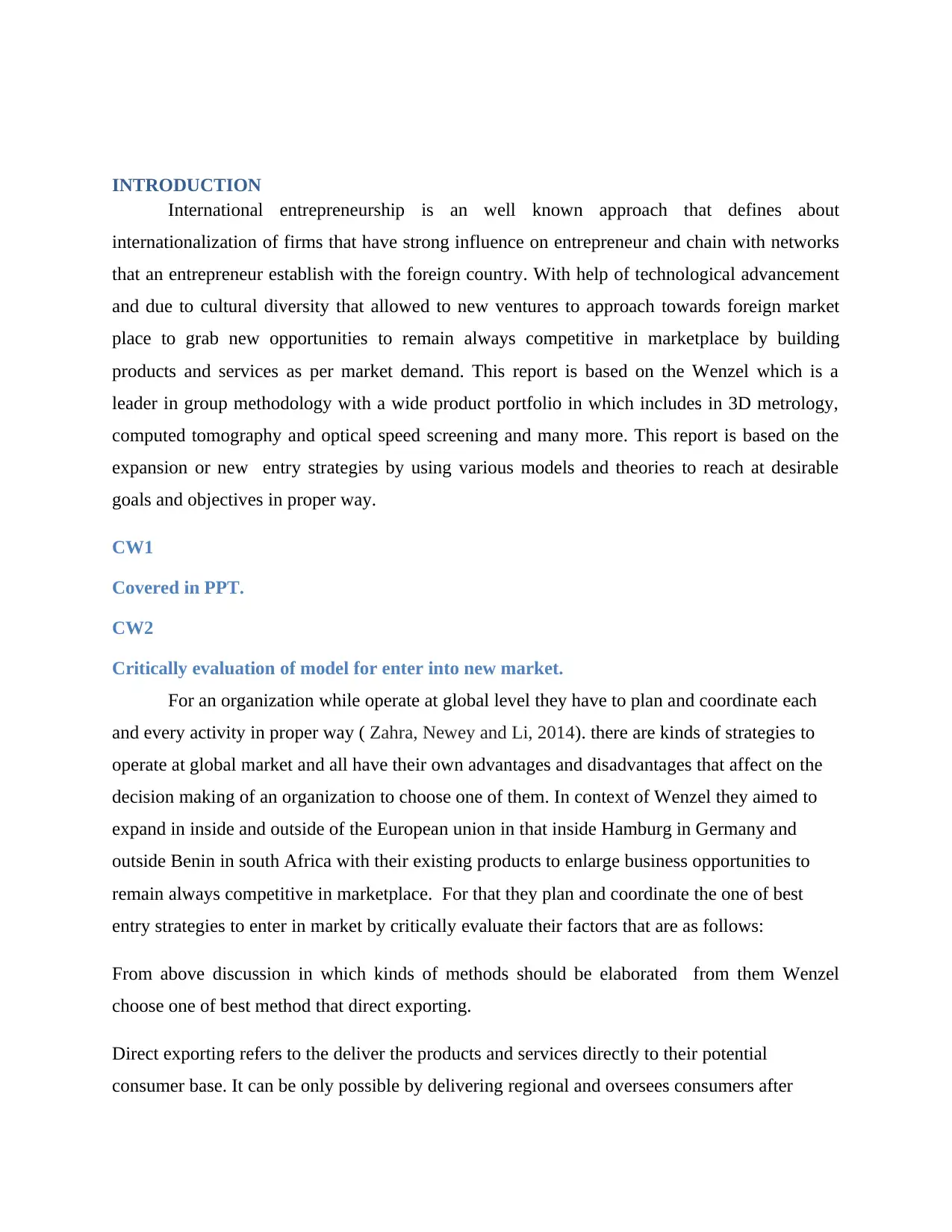
INTRODUCTION
International entrepreneurship is an well known approach that defines about
internationalization of firms that have strong influence on entrepreneur and chain with networks
that an entrepreneur establish with the foreign country. With help of technological advancement
and due to cultural diversity that allowed to new ventures to approach towards foreign market
place to grab new opportunities to remain always competitive in marketplace by building
products and services as per market demand. This report is based on the Wenzel which is a
leader in group methodology with a wide product portfolio in which includes in 3D metrology,
computed tomography and optical speed screening and many more. This report is based on the
expansion or new entry strategies by using various models and theories to reach at desirable
goals and objectives in proper way.
CW1
Covered in PPT.
CW2
Critically evaluation of model for enter into new market.
For an organization while operate at global level they have to plan and coordinate each
and every activity in proper way ( Zahra, Newey and Li, 2014). there are kinds of strategies to
operate at global market and all have their own advantages and disadvantages that affect on the
decision making of an organization to choose one of them. In context of Wenzel they aimed to
expand in inside and outside of the European union in that inside Hamburg in Germany and
outside Benin in south Africa with their existing products to enlarge business opportunities to
remain always competitive in marketplace. For that they plan and coordinate the one of best
entry strategies to enter in market by critically evaluate their factors that are as follows:
From above discussion in which kinds of methods should be elaborated from them Wenzel
choose one of best method that direct exporting.
Direct exporting refers to the deliver the products and services directly to their potential
consumer base. It can be only possible by delivering regional and oversees consumers after
International entrepreneurship is an well known approach that defines about
internationalization of firms that have strong influence on entrepreneur and chain with networks
that an entrepreneur establish with the foreign country. With help of technological advancement
and due to cultural diversity that allowed to new ventures to approach towards foreign market
place to grab new opportunities to remain always competitive in marketplace by building
products and services as per market demand. This report is based on the Wenzel which is a
leader in group methodology with a wide product portfolio in which includes in 3D metrology,
computed tomography and optical speed screening and many more. This report is based on the
expansion or new entry strategies by using various models and theories to reach at desirable
goals and objectives in proper way.
CW1
Covered in PPT.
CW2
Critically evaluation of model for enter into new market.
For an organization while operate at global level they have to plan and coordinate each
and every activity in proper way ( Zahra, Newey and Li, 2014). there are kinds of strategies to
operate at global market and all have their own advantages and disadvantages that affect on the
decision making of an organization to choose one of them. In context of Wenzel they aimed to
expand in inside and outside of the European union in that inside Hamburg in Germany and
outside Benin in south Africa with their existing products to enlarge business opportunities to
remain always competitive in marketplace. For that they plan and coordinate the one of best
entry strategies to enter in market by critically evaluate their factors that are as follows:
From above discussion in which kinds of methods should be elaborated from them Wenzel
choose one of best method that direct exporting.
Direct exporting refers to the deliver the products and services directly to their potential
consumer base. It can be only possible by delivering regional and oversees consumers after
⊘ This is a preview!⊘
Do you want full access?
Subscribe today to unlock all pages.

Trusted by 1+ million students worldwide
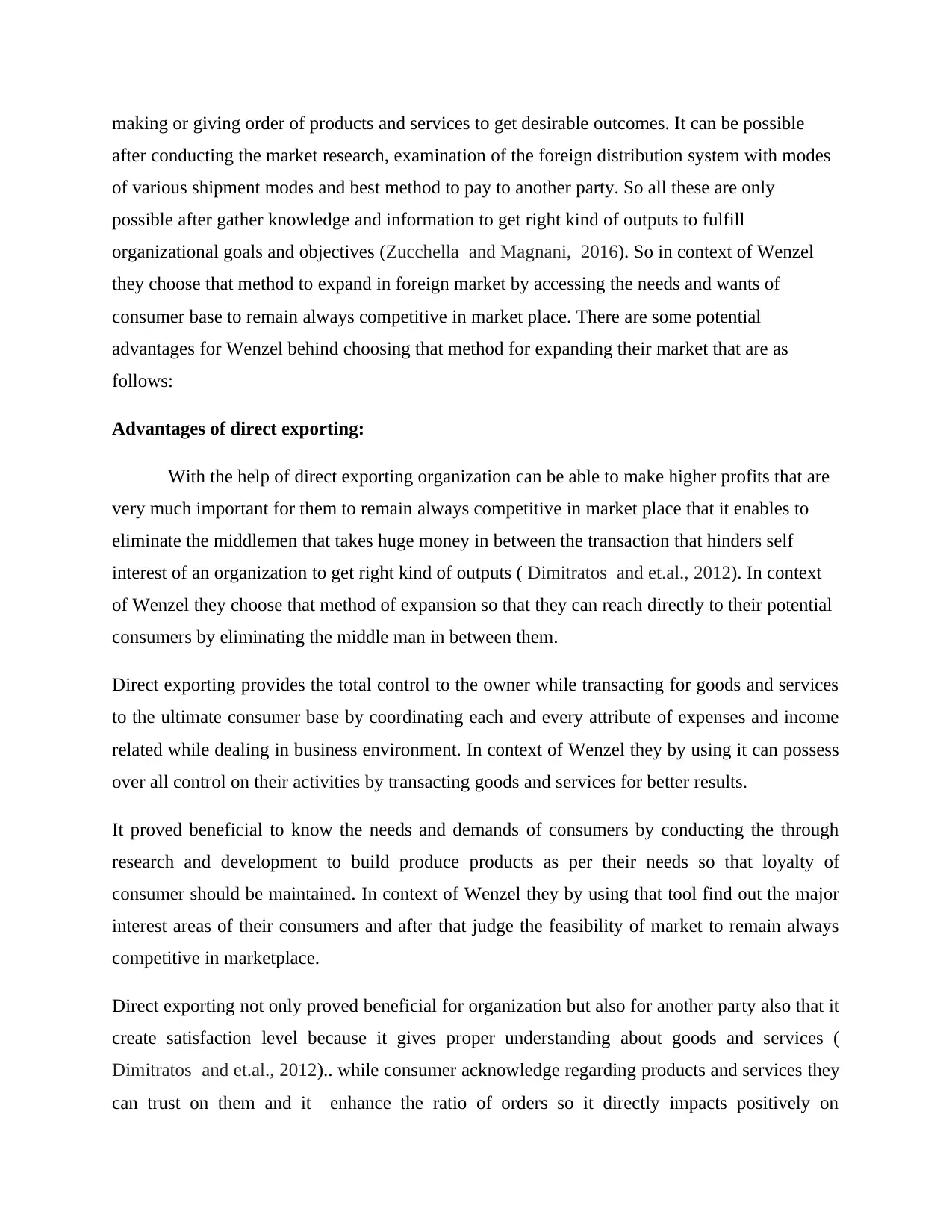
making or giving order of products and services to get desirable outcomes. It can be possible
after conducting the market research, examination of the foreign distribution system with modes
of various shipment modes and best method to pay to another party. So all these are only
possible after gather knowledge and information to get right kind of outputs to fulfill
organizational goals and objectives (Zucchella and Magnani, 2016). So in context of Wenzel
they choose that method to expand in foreign market by accessing the needs and wants of
consumer base to remain always competitive in market place. There are some potential
advantages for Wenzel behind choosing that method for expanding their market that are as
follows:
Advantages of direct exporting:
With the help of direct exporting organization can be able to make higher profits that are
very much important for them to remain always competitive in market place that it enables to
eliminate the middlemen that takes huge money in between the transaction that hinders self
interest of an organization to get right kind of outputs ( Dimitratos and et.al., 2012). In context
of Wenzel they choose that method of expansion so that they can reach directly to their potential
consumers by eliminating the middle man in between them.
Direct exporting provides the total control to the owner while transacting for goods and services
to the ultimate consumer base by coordinating each and every attribute of expenses and income
related while dealing in business environment. In context of Wenzel they by using it can possess
over all control on their activities by transacting goods and services for better results.
It proved beneficial to know the needs and demands of consumers by conducting the through
research and development to build produce products as per their needs so that loyalty of
consumer should be maintained. In context of Wenzel they by using that tool find out the major
interest areas of their consumers and after that judge the feasibility of market to remain always
competitive in marketplace.
Direct exporting not only proved beneficial for organization but also for another party also that it
create satisfaction level because it gives proper understanding about goods and services (
Dimitratos and et.al., 2012).. while consumer acknowledge regarding products and services they
can trust on them and it enhance the ratio of orders so it directly impacts positively on
after conducting the market research, examination of the foreign distribution system with modes
of various shipment modes and best method to pay to another party. So all these are only
possible after gather knowledge and information to get right kind of outputs to fulfill
organizational goals and objectives (Zucchella and Magnani, 2016). So in context of Wenzel
they choose that method to expand in foreign market by accessing the needs and wants of
consumer base to remain always competitive in market place. There are some potential
advantages for Wenzel behind choosing that method for expanding their market that are as
follows:
Advantages of direct exporting:
With the help of direct exporting organization can be able to make higher profits that are
very much important for them to remain always competitive in market place that it enables to
eliminate the middlemen that takes huge money in between the transaction that hinders self
interest of an organization to get right kind of outputs ( Dimitratos and et.al., 2012). In context
of Wenzel they choose that method of expansion so that they can reach directly to their potential
consumers by eliminating the middle man in between them.
Direct exporting provides the total control to the owner while transacting for goods and services
to the ultimate consumer base by coordinating each and every attribute of expenses and income
related while dealing in business environment. In context of Wenzel they by using it can possess
over all control on their activities by transacting goods and services for better results.
It proved beneficial to know the needs and demands of consumers by conducting the through
research and development to build produce products as per their needs so that loyalty of
consumer should be maintained. In context of Wenzel they by using that tool find out the major
interest areas of their consumers and after that judge the feasibility of market to remain always
competitive in marketplace.
Direct exporting not only proved beneficial for organization but also for another party also that it
create satisfaction level because it gives proper understanding about goods and services (
Dimitratos and et.al., 2012).. while consumer acknowledge regarding products and services they
can trust on them and it enhance the ratio of orders so it directly impacts positively on
Paraphrase This Document
Need a fresh take? Get an instant paraphrase of this document with our AI Paraphraser
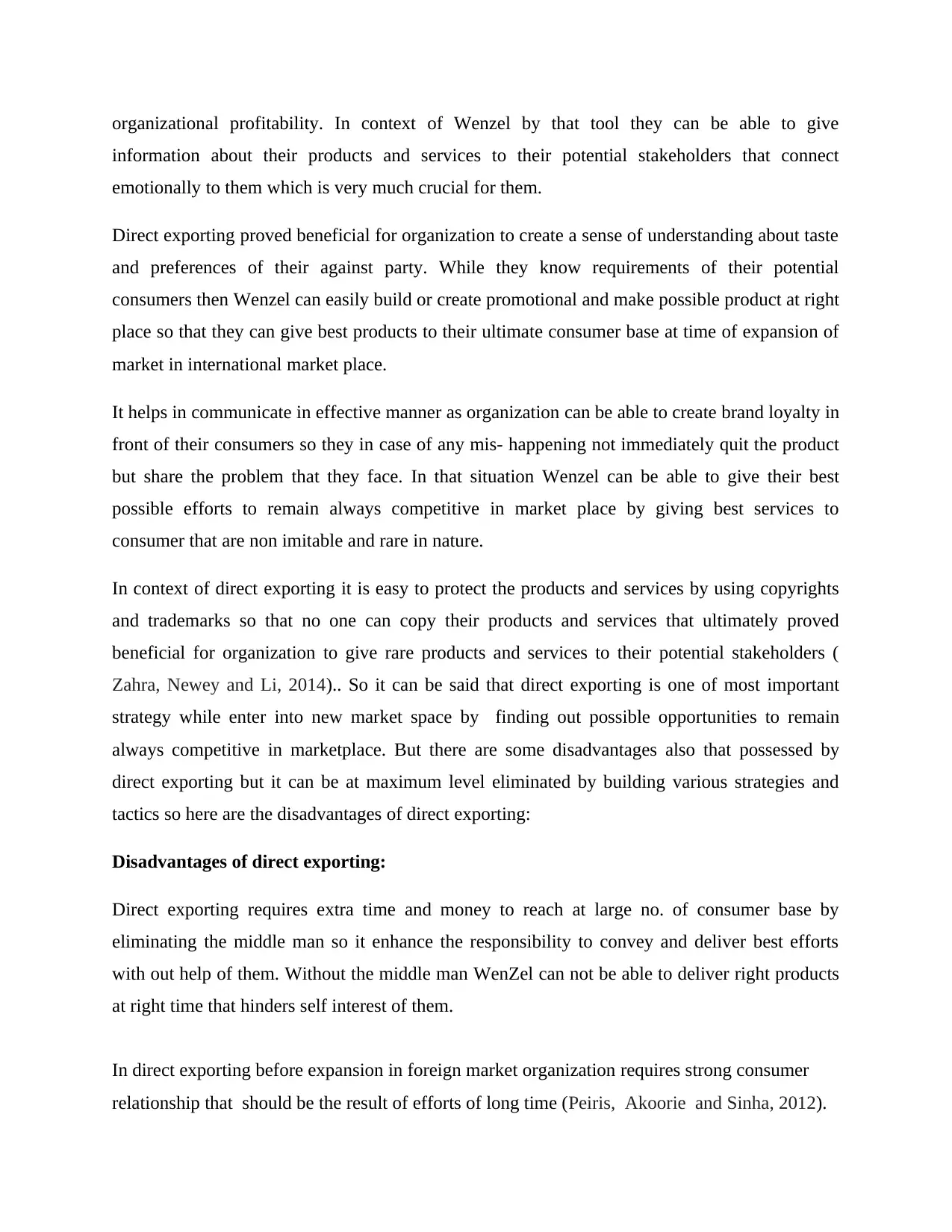
organizational profitability. In context of Wenzel by that tool they can be able to give
information about their products and services to their potential stakeholders that connect
emotionally to them which is very much crucial for them.
Direct exporting proved beneficial for organization to create a sense of understanding about taste
and preferences of their against party. While they know requirements of their potential
consumers then Wenzel can easily build or create promotional and make possible product at right
place so that they can give best products to their ultimate consumer base at time of expansion of
market in international market place.
It helps in communicate in effective manner as organization can be able to create brand loyalty in
front of their consumers so they in case of any mis- happening not immediately quit the product
but share the problem that they face. In that situation Wenzel can be able to give their best
possible efforts to remain always competitive in market place by giving best services to
consumer that are non imitable and rare in nature.
In context of direct exporting it is easy to protect the products and services by using copyrights
and trademarks so that no one can copy their products and services that ultimately proved
beneficial for organization to give rare products and services to their potential stakeholders (
Zahra, Newey and Li, 2014).. So it can be said that direct exporting is one of most important
strategy while enter into new market space by finding out possible opportunities to remain
always competitive in marketplace. But there are some disadvantages also that possessed by
direct exporting but it can be at maximum level eliminated by building various strategies and
tactics so here are the disadvantages of direct exporting:
Disadvantages of direct exporting:
Direct exporting requires extra time and money to reach at large no. of consumer base by
eliminating the middle man so it enhance the responsibility to convey and deliver best efforts
with out help of them. Without the middle man WenZel can not be able to deliver right products
at right time that hinders self interest of them.
In direct exporting before expansion in foreign market organization requires strong consumer
relationship that should be the result of efforts of long time (Peiris, Akoorie and Sinha, 2012).
information about their products and services to their potential stakeholders that connect
emotionally to them which is very much crucial for them.
Direct exporting proved beneficial for organization to create a sense of understanding about taste
and preferences of their against party. While they know requirements of their potential
consumers then Wenzel can easily build or create promotional and make possible product at right
place so that they can give best products to their ultimate consumer base at time of expansion of
market in international market place.
It helps in communicate in effective manner as organization can be able to create brand loyalty in
front of their consumers so they in case of any mis- happening not immediately quit the product
but share the problem that they face. In that situation Wenzel can be able to give their best
possible efforts to remain always competitive in market place by giving best services to
consumer that are non imitable and rare in nature.
In context of direct exporting it is easy to protect the products and services by using copyrights
and trademarks so that no one can copy their products and services that ultimately proved
beneficial for organization to give rare products and services to their potential stakeholders (
Zahra, Newey and Li, 2014).. So it can be said that direct exporting is one of most important
strategy while enter into new market space by finding out possible opportunities to remain
always competitive in marketplace. But there are some disadvantages also that possessed by
direct exporting but it can be at maximum level eliminated by building various strategies and
tactics so here are the disadvantages of direct exporting:
Disadvantages of direct exporting:
Direct exporting requires extra time and money to reach at large no. of consumer base by
eliminating the middle man so it enhance the responsibility to convey and deliver best efforts
with out help of them. Without the middle man WenZel can not be able to deliver right products
at right time that hinders self interest of them.
In direct exporting before expansion in foreign market organization requires strong consumer
relationship that should be the result of efforts of long time (Peiris, Akoorie and Sinha, 2012).
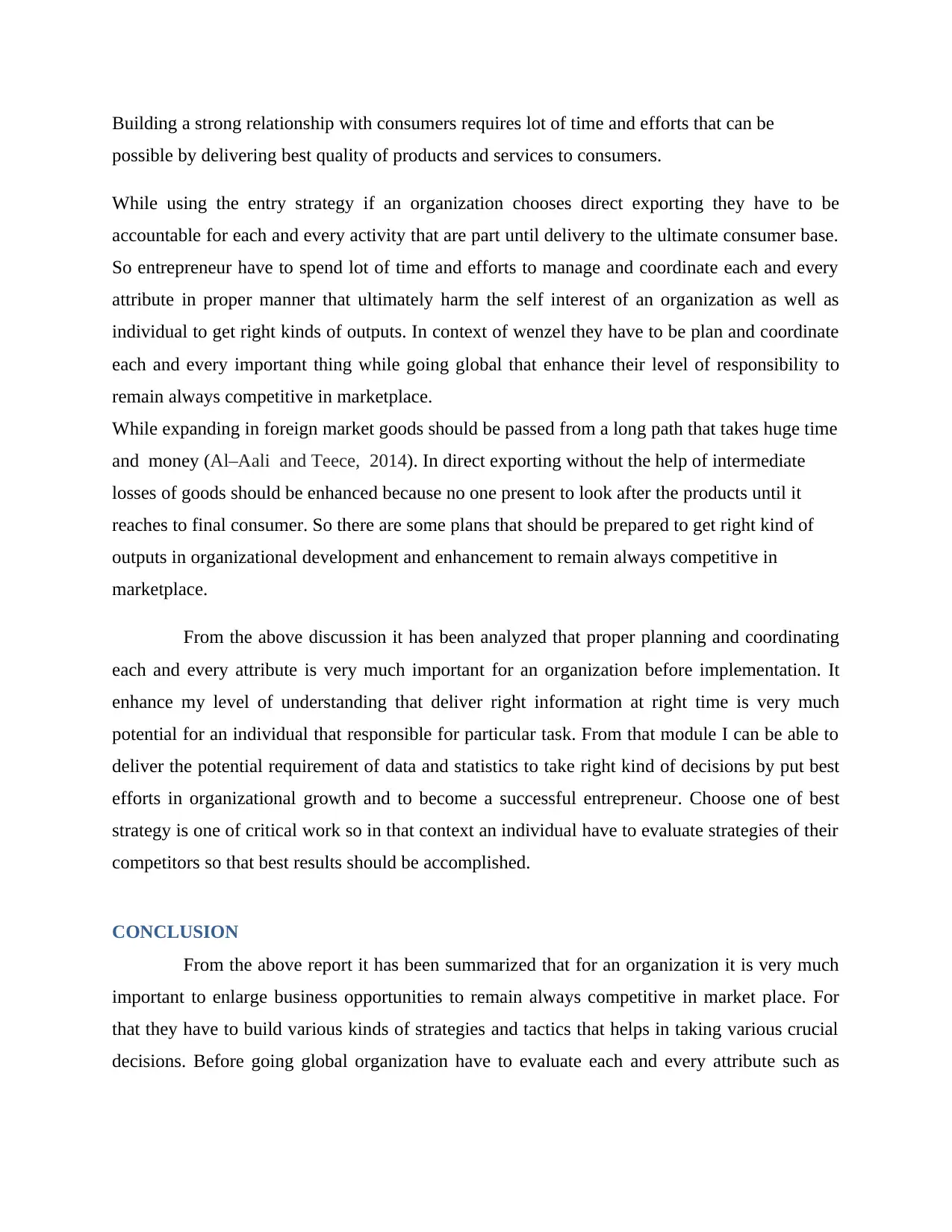
Building a strong relationship with consumers requires lot of time and efforts that can be
possible by delivering best quality of products and services to consumers.
While using the entry strategy if an organization chooses direct exporting they have to be
accountable for each and every activity that are part until delivery to the ultimate consumer base.
So entrepreneur have to spend lot of time and efforts to manage and coordinate each and every
attribute in proper manner that ultimately harm the self interest of an organization as well as
individual to get right kinds of outputs. In context of wenzel they have to be plan and coordinate
each and every important thing while going global that enhance their level of responsibility to
remain always competitive in marketplace.
While expanding in foreign market goods should be passed from a long path that takes huge time
and money (Al–Aali and Teece, 2014). In direct exporting without the help of intermediate
losses of goods should be enhanced because no one present to look after the products until it
reaches to final consumer. So there are some plans that should be prepared to get right kind of
outputs in organizational development and enhancement to remain always competitive in
marketplace.
From the above discussion it has been analyzed that proper planning and coordinating
each and every attribute is very much important for an organization before implementation. It
enhance my level of understanding that deliver right information at right time is very much
potential for an individual that responsible for particular task. From that module I can be able to
deliver the potential requirement of data and statistics to take right kind of decisions by put best
efforts in organizational growth and to become a successful entrepreneur. Choose one of best
strategy is one of critical work so in that context an individual have to evaluate strategies of their
competitors so that best results should be accomplished.
CONCLUSION
From the above report it has been summarized that for an organization it is very much
important to enlarge business opportunities to remain always competitive in market place. For
that they have to build various kinds of strategies and tactics that helps in taking various crucial
decisions. Before going global organization have to evaluate each and every attribute such as
possible by delivering best quality of products and services to consumers.
While using the entry strategy if an organization chooses direct exporting they have to be
accountable for each and every activity that are part until delivery to the ultimate consumer base.
So entrepreneur have to spend lot of time and efforts to manage and coordinate each and every
attribute in proper manner that ultimately harm the self interest of an organization as well as
individual to get right kinds of outputs. In context of wenzel they have to be plan and coordinate
each and every important thing while going global that enhance their level of responsibility to
remain always competitive in marketplace.
While expanding in foreign market goods should be passed from a long path that takes huge time
and money (Al–Aali and Teece, 2014). In direct exporting without the help of intermediate
losses of goods should be enhanced because no one present to look after the products until it
reaches to final consumer. So there are some plans that should be prepared to get right kind of
outputs in organizational development and enhancement to remain always competitive in
marketplace.
From the above discussion it has been analyzed that proper planning and coordinating
each and every attribute is very much important for an organization before implementation. It
enhance my level of understanding that deliver right information at right time is very much
potential for an individual that responsible for particular task. From that module I can be able to
deliver the potential requirement of data and statistics to take right kind of decisions by put best
efforts in organizational growth and to become a successful entrepreneur. Choose one of best
strategy is one of critical work so in that context an individual have to evaluate strategies of their
competitors so that best results should be accomplished.
CONCLUSION
From the above report it has been summarized that for an organization it is very much
important to enlarge business opportunities to remain always competitive in market place. For
that they have to build various kinds of strategies and tactics that helps in taking various crucial
decisions. Before going global organization have to evaluate each and every attribute such as
⊘ This is a preview!⊘
Do you want full access?
Subscribe today to unlock all pages.

Trusted by 1+ million students worldwide

feasibility of market, competitors strategy and taste and preferences of consumers and many
more so that better results should be accomplished.
more so that better results should be accomplished.
Paraphrase This Document
Need a fresh take? Get an instant paraphrase of this document with our AI Paraphraser
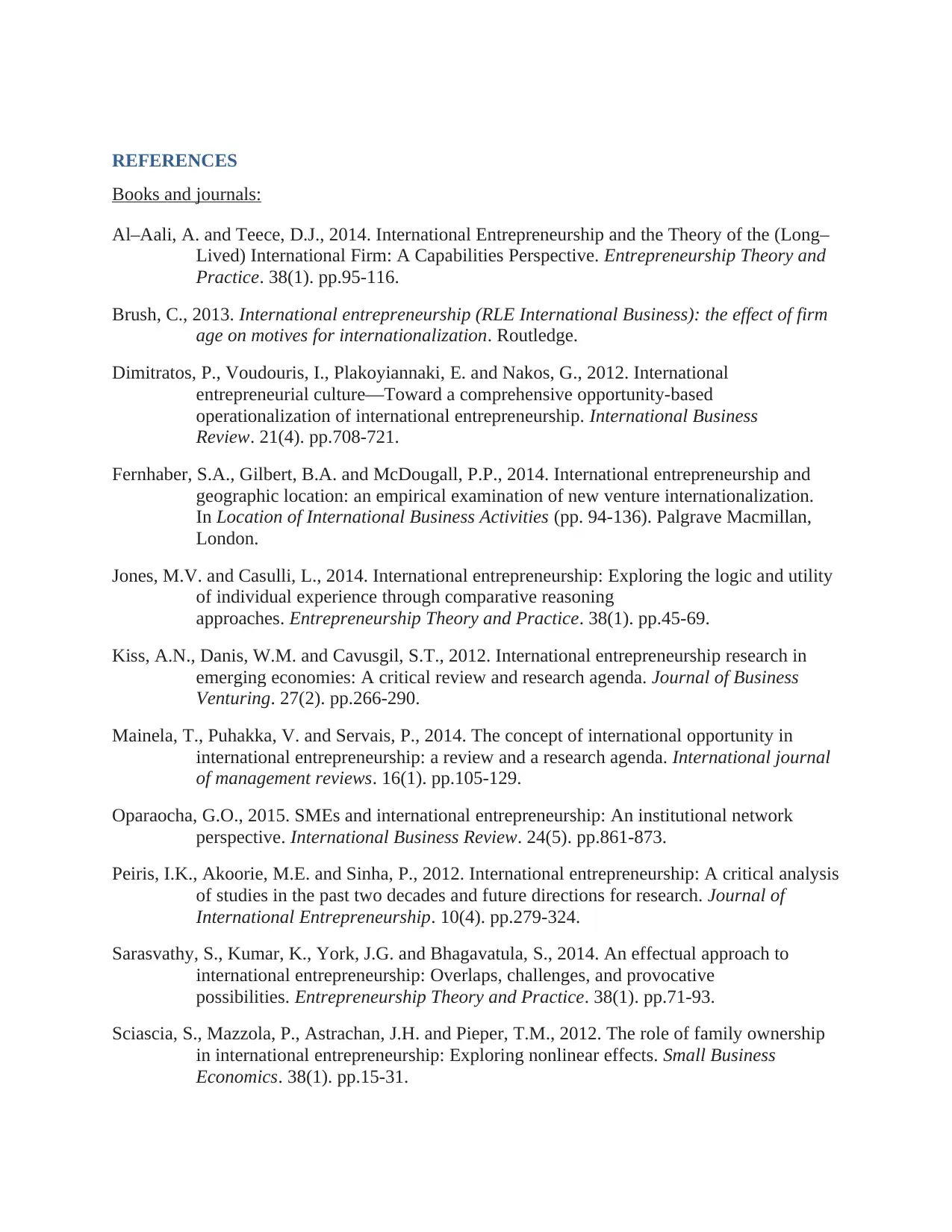
REFERENCES
Books and journals:
Al–Aali, A. and Teece, D.J., 2014. International Entrepreneurship and the Theory of the (Long–
Lived) International Firm: A Capabilities Perspective. Entrepreneurship Theory and
Practice. 38(1). pp.95-116.
Brush, C., 2013. International entrepreneurship (RLE International Business): the effect of firm
age on motives for internationalization. Routledge.
Dimitratos, P., Voudouris, I., Plakoyiannaki, E. and Nakos, G., 2012. International
entrepreneurial culture—Toward a comprehensive opportunity-based
operationalization of international entrepreneurship. International Business
Review. 21(4). pp.708-721.
Fernhaber, S.A., Gilbert, B.A. and McDougall, P.P., 2014. International entrepreneurship and
geographic location: an empirical examination of new venture internationalization.
In Location of International Business Activities (pp. 94-136). Palgrave Macmillan,
London.
Jones, M.V. and Casulli, L., 2014. International entrepreneurship: Exploring the logic and utility
of individual experience through comparative reasoning
approaches. Entrepreneurship Theory and Practice. 38(1). pp.45-69.
Kiss, A.N., Danis, W.M. and Cavusgil, S.T., 2012. International entrepreneurship research in
emerging economies: A critical review and research agenda. Journal of Business
Venturing. 27(2). pp.266-290.
Mainela, T., Puhakka, V. and Servais, P., 2014. The concept of international opportunity in
international entrepreneurship: a review and a research agenda. International journal
of management reviews. 16(1). pp.105-129.
Oparaocha, G.O., 2015. SMEs and international entrepreneurship: An institutional network
perspective. International Business Review. 24(5). pp.861-873.
Peiris, I.K., Akoorie, M.E. and Sinha, P., 2012. International entrepreneurship: A critical analysis
of studies in the past two decades and future directions for research. Journal of
International Entrepreneurship. 10(4). pp.279-324.
Sarasvathy, S., Kumar, K., York, J.G. and Bhagavatula, S., 2014. An effectual approach to
international entrepreneurship: Overlaps, challenges, and provocative
possibilities. Entrepreneurship Theory and Practice. 38(1). pp.71-93.
Sciascia, S., Mazzola, P., Astrachan, J.H. and Pieper, T.M., 2012. The role of family ownership
in international entrepreneurship: Exploring nonlinear effects. Small Business
Economics. 38(1). pp.15-31.
Books and journals:
Al–Aali, A. and Teece, D.J., 2014. International Entrepreneurship and the Theory of the (Long–
Lived) International Firm: A Capabilities Perspective. Entrepreneurship Theory and
Practice. 38(1). pp.95-116.
Brush, C., 2013. International entrepreneurship (RLE International Business): the effect of firm
age on motives for internationalization. Routledge.
Dimitratos, P., Voudouris, I., Plakoyiannaki, E. and Nakos, G., 2012. International
entrepreneurial culture—Toward a comprehensive opportunity-based
operationalization of international entrepreneurship. International Business
Review. 21(4). pp.708-721.
Fernhaber, S.A., Gilbert, B.A. and McDougall, P.P., 2014. International entrepreneurship and
geographic location: an empirical examination of new venture internationalization.
In Location of International Business Activities (pp. 94-136). Palgrave Macmillan,
London.
Jones, M.V. and Casulli, L., 2014. International entrepreneurship: Exploring the logic and utility
of individual experience through comparative reasoning
approaches. Entrepreneurship Theory and Practice. 38(1). pp.45-69.
Kiss, A.N., Danis, W.M. and Cavusgil, S.T., 2012. International entrepreneurship research in
emerging economies: A critical review and research agenda. Journal of Business
Venturing. 27(2). pp.266-290.
Mainela, T., Puhakka, V. and Servais, P., 2014. The concept of international opportunity in
international entrepreneurship: a review and a research agenda. International journal
of management reviews. 16(1). pp.105-129.
Oparaocha, G.O., 2015. SMEs and international entrepreneurship: An institutional network
perspective. International Business Review. 24(5). pp.861-873.
Peiris, I.K., Akoorie, M.E. and Sinha, P., 2012. International entrepreneurship: A critical analysis
of studies in the past two decades and future directions for research. Journal of
International Entrepreneurship. 10(4). pp.279-324.
Sarasvathy, S., Kumar, K., York, J.G. and Bhagavatula, S., 2014. An effectual approach to
international entrepreneurship: Overlaps, challenges, and provocative
possibilities. Entrepreneurship Theory and Practice. 38(1). pp.71-93.
Sciascia, S., Mazzola, P., Astrachan, J.H. and Pieper, T.M., 2012. The role of family ownership
in international entrepreneurship: Exploring nonlinear effects. Small Business
Economics. 38(1). pp.15-31.
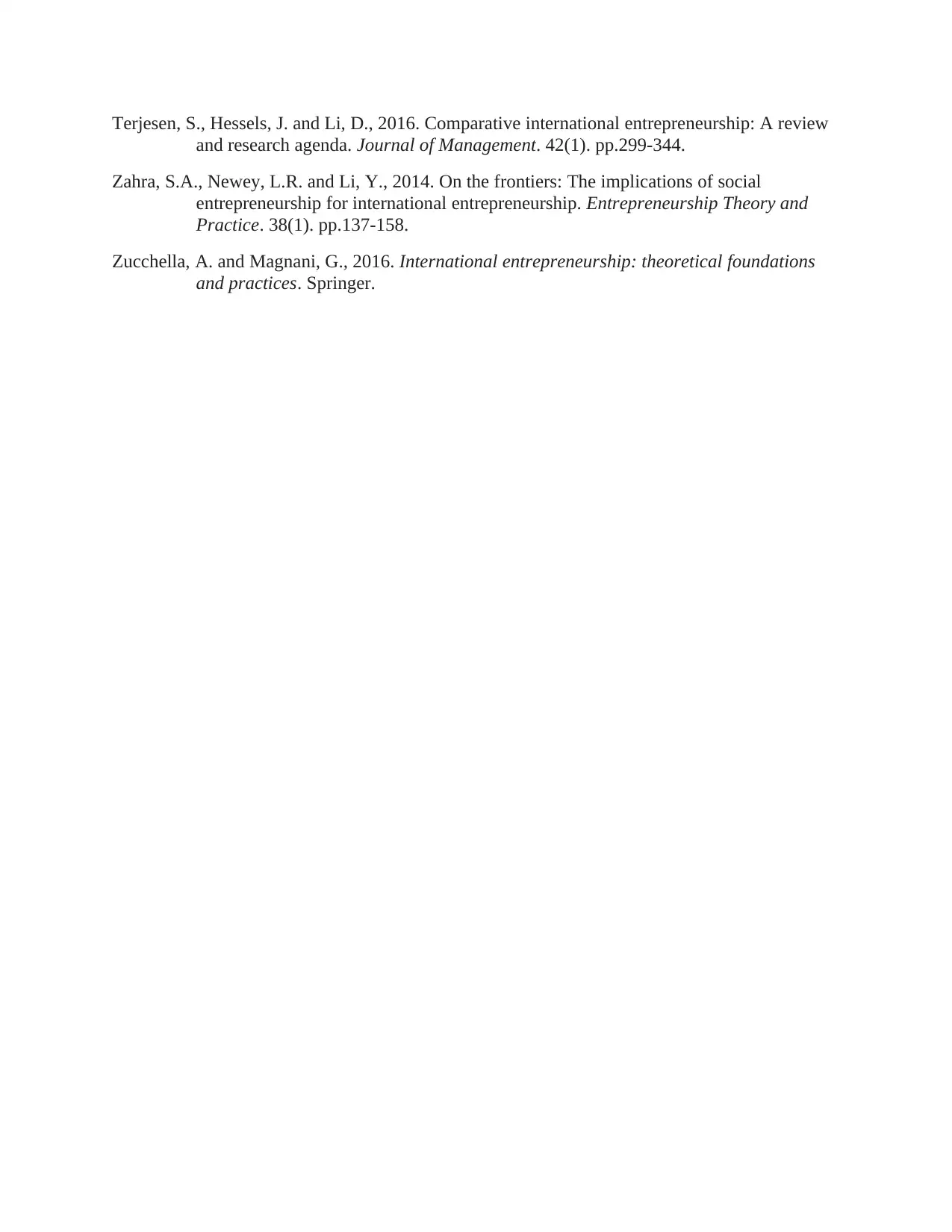
Terjesen, S., Hessels, J. and Li, D., 2016. Comparative international entrepreneurship: A review
and research agenda. Journal of Management. 42(1). pp.299-344.
Zahra, S.A., Newey, L.R. and Li, Y., 2014. On the frontiers: The implications of social
entrepreneurship for international entrepreneurship. Entrepreneurship Theory and
Practice. 38(1). pp.137-158.
Zucchella, A. and Magnani, G., 2016. International entrepreneurship: theoretical foundations
and practices. Springer.
and research agenda. Journal of Management. 42(1). pp.299-344.
Zahra, S.A., Newey, L.R. and Li, Y., 2014. On the frontiers: The implications of social
entrepreneurship for international entrepreneurship. Entrepreneurship Theory and
Practice. 38(1). pp.137-158.
Zucchella, A. and Magnani, G., 2016. International entrepreneurship: theoretical foundations
and practices. Springer.
⊘ This is a preview!⊘
Do you want full access?
Subscribe today to unlock all pages.

Trusted by 1+ million students worldwide
1 out of 9
Related Documents
Your All-in-One AI-Powered Toolkit for Academic Success.
+13062052269
info@desklib.com
Available 24*7 on WhatsApp / Email
![[object Object]](/_next/static/media/star-bottom.7253800d.svg)
Unlock your academic potential
Copyright © 2020–2025 A2Z Services. All Rights Reserved. Developed and managed by ZUCOL.





